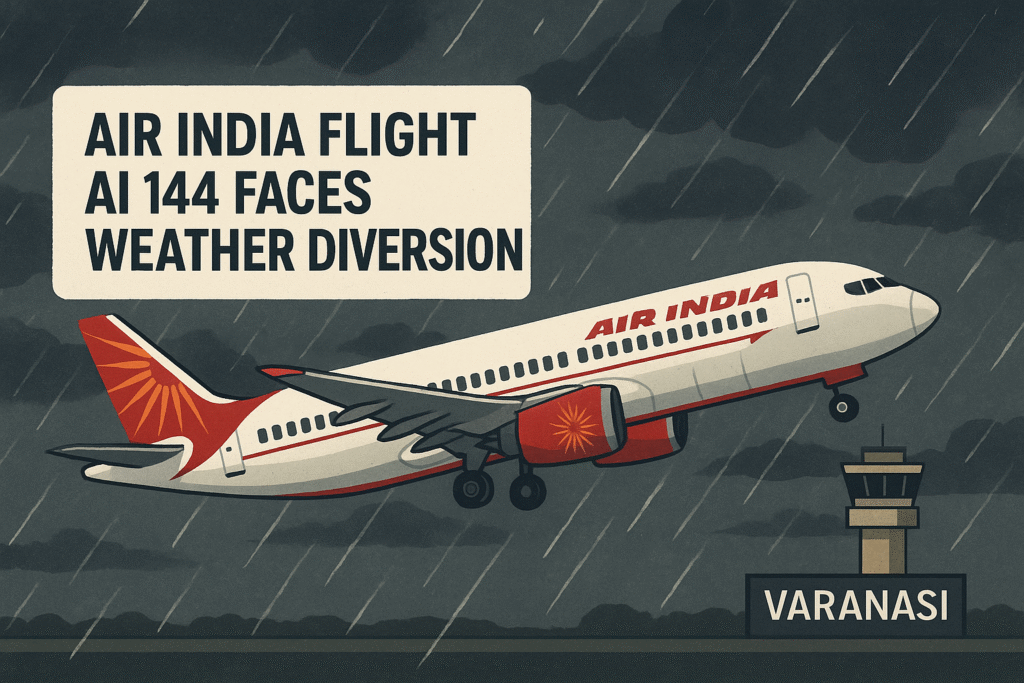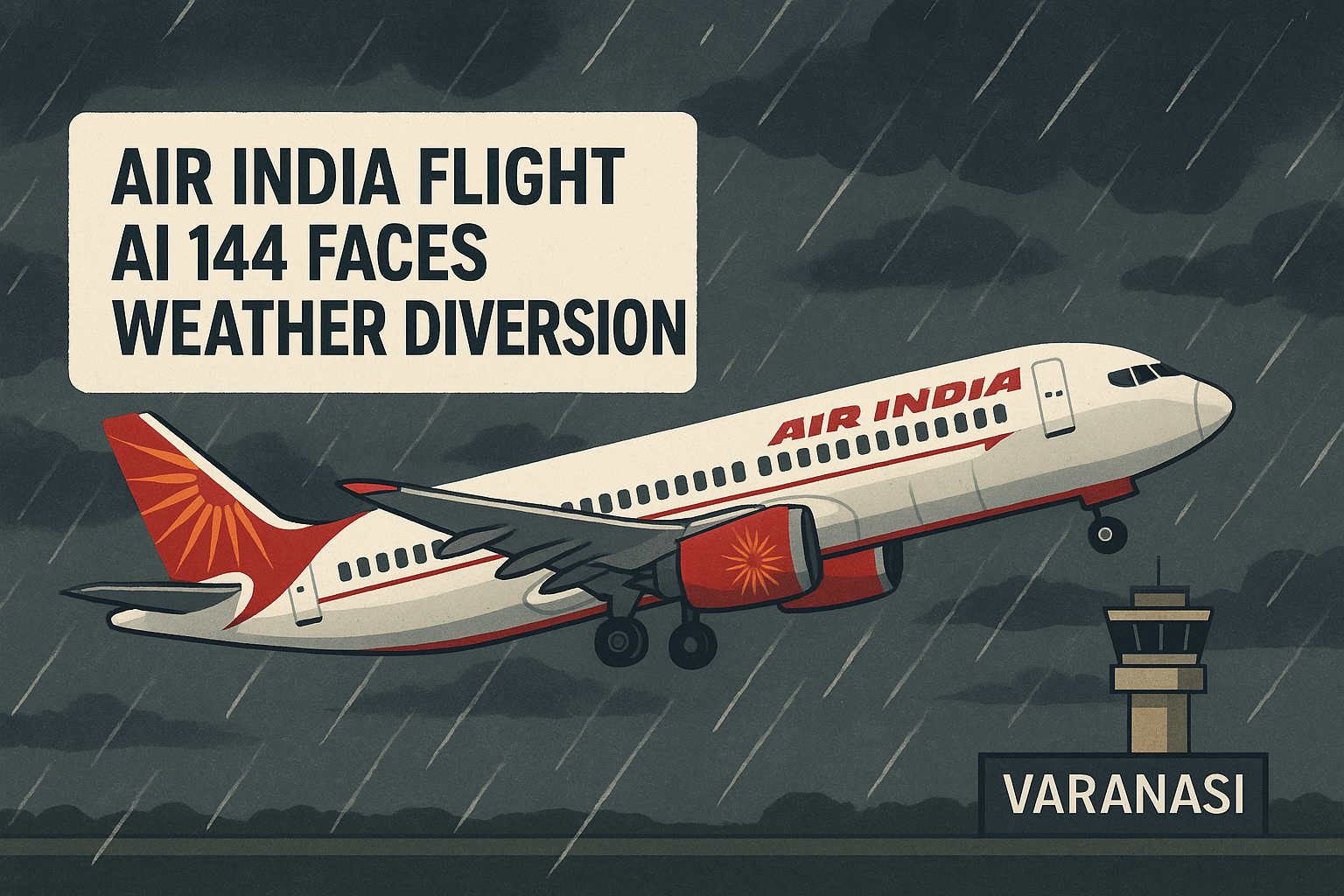
Air India Flight AI 144 Faces Weather Diversion — In an unexpected turn of events, an Air India flight en route from Bali to Delhi had to be diverted to Varanasi’s Lal Bahadur Shastri International Airport due to severe weather conditions over Delhi. The incident occurred on Wednesday, June 18, 2025, when heavy rain and low visibility made landing in the national capital impossible.
The flight, originally scheduled to land at Indira Gandhi International Airport (IGI), Delhi, was rerouted mid-air after pilots encountered poor visibility and adverse weather patterns in the Delhi-NCR region. The decision to divert the flight to Varanasi was made in the interest of passenger safety, according to Air India officials.
As Air India Flight AI 144 Faces Weather Diversion, passengers were left facing a delay, but officials ensured a smooth alternative landing and proper arrangements on the ground.
✈️ Air India Flight AI 144 Faces Weather Diversion: What Happened?
Air India Flight AI 144 Faces Weather Diversion due to deteriorating weather conditions over Delhi on June 18. The Boeing aircraft, carrying passengers from Bali (Indonesia) to New Delhi, was nearing its final approach when pilots were alerted to the low visibility triggered by heavy rainfall and thick cloud cover over the city.
In response to this, the flight crew followed standard aviation protocol and coordinated with air traffic control (ATC) to identify an alternate airport. Varanasi, which had clearer skies at the time, was chosen as the most suitable diversion point. The aircraft landed safely at Lal Bahadur Shastri International Airport, Varanasi.
Officials confirmed that no technical issues were involved. The diversion was solely due to inclement weather, aligning with aviation safety standards. As Air India Flight AI 144 Faces Weather Diversion, it highlights how critical weather assessments are in ensuring passenger and crew safety.
📍 Why Was Delhi’s Airport Not an Option?
As Air India Flight AI 144 Faces Weather Diversion, the situation underscores the ongoing challenges posed by Delhi’s monsoon weather. On June 18, the India Meteorological Department (IMD) had already forecast moderate to heavy rainfall over Delhi and adjoining regions.
The rain drastically reduced runway visibility below permissible landing limits, especially for wide-bodied aircraft like the one used on this international route. When visibility drops below 800 meters, landings become unsafe and pilots may request diversion to the nearest alternate airfield.
By the time Air India Flight AI 144 Faces Weather Diversion, multiple flights were reportedly holding in the air or being rerouted, placing additional pressure on ATC to manage congestion and maintain safety.
📋 Timeline of Events: How Air India Handled the Diversion
Let’s take a closer look at the sequence of events as Air India Flight AI 144 Faces Weather Diversion:
- Scheduled Arrival in Delhi: 8:10 AM IST
- Weather Alert Issued: 7:50 AM IST by Delhi ATC
- Diversion Decision Made: 8:00 AM IST
- Landing in Varanasi: Around 9:20 AM IST
- Passenger Update: Issued at 9:45 AM by Air India via SMS and announcements
- Alternate Transport Plan: Being coordinated as of latest reports
As Air India Flight AI 144 Faces Weather Diversion, airline staff and ground crew at Varanasi promptly arranged refreshment facilities and updates for passengers. Air India also confirmed that alternate travel arrangements to Delhi would be provided either via a ferry flight or connecting flights later in the day, depending on weather improvement.
👨✈️ Pilot and Crew Response During the Diversion
According to aviation insiders, the pilots acted swiftly and with utmost professionalism as Air India Flight AI 144 Faces Weather Diversion. They followed Instrument Landing System (ILS) protocols and communicated consistently with Delhi and Varanasi ATC units.
The captain reportedly announced the diversion to passengers in advance, explaining that safety protocols dictated an alternate landing due to adverse weather. As turbulence was also reported in the region, the crew remained attentive and reassured passengers during the unexpected change in schedule.
🛬 What Happens After a Flight Diversion?
When Air India Flight AI 144 Faces Weather Diversion, standard procedures include:
- Re-routing to the nearest operational airport
- Coordination between ATC, airline operations, and ground staff
- Refueling, if needed
- Crew rest considerations
- Roster adjustments for duty-hour compliance
- Passenger support on-ground
As the situation evolves, the airline will decide whether to continue the journey to Delhi once conditions improve or accommodate passengers on connecting flights or alternative ground transport.
🌦️ Weather Impact on Delhi Flight Operations
With Air India Flight AI 144 Faces Weather Diversion, it’s a reminder that Delhi’s Indira Gandhi International Airport often experiences operational disruptions during the monsoon season.
Visibility reduction, runway wetness, and crosswinds contribute to delays and diversions, especially in early morning or late-night slots. On June 18, at least 5 other flights were also reportedly affected by the bad weather.
Meteorological authorities confirmed that Delhi recorded 45 mm of rain in just two hours, triggering urban flooding in parts of the city and severely affecting air traffic.
🧳 Passenger Reactions: Calm Amid Chaos
As Air India Flight AI 144 Faces Weather Diversion, passengers remained mostly cooperative, according to on-ground reports. While many were initially confused or concerned, frequent announcements and updates helped maintain calm.
One passenger shared on social media:
“We were circling for quite some time. The pilot finally told us about the diversion to Varanasi due to bad weather. Smooth landing, kudos to the crew.”
Air India, in its official statement, reiterated that passenger comfort and safety remain its highest priorities.
🛫 Will There Be More Flight Disruptions?
As Air India Flight AI 144 Faces Weather Diversion, aviation experts advise that more such incidents may occur during the peak monsoon months. The IMD has warned of continued rainfall patterns over Delhi, with several advisories already in place for airports across northern India.
Air travelers are advised to:
- Check flight status frequently
- Allow extra travel time
- Opt for flexible flight bookings
- Stay connected with airlines via official apps and SMS
📢 Official Statement from Air India
Responding to the media after Air India Flight AI 144 Faces Weather Diversion, a spokesperson from Air India stated:
“Flight AI 144 operating from Bali to Delhi was diverted to Varanasi due to sudden deterioration in weather conditions at Delhi Airport. The safety of our passengers is our top priority. Necessary support and alternate arrangements are being made at Varanasi.”
✅ Conclusion: Air India Flight AI 144 Faces Weather Diversion Highlights Monsoon Challenges
With Air India Flight AI 144 Faces Weather Diversion, the incident is a timely reminder of the complexities of operating flights during unpredictable weather seasons. While the diversion led to temporary inconvenience, the airline’s swift response, coupled with ATC coordination, ensured passenger safety was never compromised.
As passengers await resumption of travel to Delhi, the situation remains under close watch by both Air India and aviation authorities.
Stay tuned for updates. Air India Flight AI 144 Faces Weather Diversion — but safety takes priority.

One thought on “Air India Flight AI 144 Faces Weather Diversion, Lands in Varanasi Instead of Delhi”
Comments are closed.